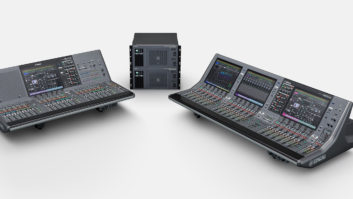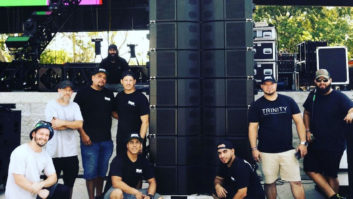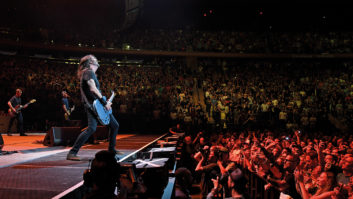Los Angeles, CA—There ought to be a photo of Tori Amos in the dictionary next to the word “constancy.” She tours almost nonstop, releases a new album every other year or so that inevitably enters Billboard’s Top 10, and has retained essentially the same road crew, production team and sound company for decades.
In December, Amos wrapped up the North American leg of her tour with three sold-out nights at The Theatre at Ace Hotel in downtown Los Angeles, the latest dates on a world tour that began in Europe in September 2017, coincident with the release of her 15th studio album, Native Invader. But as front-of-house engineer Mark Hawley observes, to call this the “latest” tour is something of a misnomer. “We really started 23 years ago,” he says. “She enjoys touring.”

Hawley joined the Tori Amos roadshow in 1994, when she began using UK-based sound production company SSE Hire. Her tour manager, John Witherspoon, knew Hawley from their time together with World Party, another SSE account. Hawley brought along his friend Marcel van Limbeek to mix monitors.
Twenty-three years down the road, the relationships endure. Engineering not just on the road, Hawley and van Limbeek have also worked in the studio with Amos on every album since her third, in 1994. In 1997, Amos, Hawley and van Limbeek established a Neve VR-equipped recording studio, Martian Engineering, on the south coast of England. And in 1998, Hawley and Amos were married.
Related: Live Sound Showcase: Metallica, by Steve La Cerra, Pro Sound News, July 5, 2017
Witherspoon is now Amos’ manager and SSE Audio Group continues to supply the PA package. But whereas previously SSE would ship a container of gear to the U.S., a new partnership with Sound Image in Escondido, CA, dubbed UAC (United Audio Companies), meant that this time, an identical system was awaiting the tour party when it arrived from Europe.
SSE project manager Pete Russell’s specification for the Native Invader tour included a pair of DiGiCo SD12 desks, running at 96k to minimize in-ear monitor latency, and an L-Acoustics speaker rig—K2 for the larger European halls, and Kara arrays and SB18 subs, with Kiva II and X12 available for fill, for the smaller venues and the U.S. excursion. SSE Hire provided two new SD12 consoles to support the European leg of the tour. The SSE road crew included system tech Miles Barton and monitor tech Andy Yates.

While a Tori Amos concert may feature the singer with just a piano or electronic keyboard, “It’s really a rock and roll show,” says Hawley. “If it’s not in your face and huge sounding, it makes it difficult for her to get the point across. So that’s my first job. Then to make it sound as interesting as possible.”
To that end, Hawley relies on a rack of high-end outboard gear, largely duplicated at monitorworld, that wouldn’t look out of place in the studio. “I’m using parallel compression on the vocal, with an 1176, an LA-2A and a [Manley] Massive Passive,” says Hawley.
Related: Live Sound Showcase: Arcade Fire, by Lowell Greenblatt, Pro Sound News, Nov. 7, 2017
The vocal chain starts with Heil Sound PR 35 dynamic mics at the opposite-facing keyboard positions. “The Heil has this lovely top-end,” he says. “We put it through a Neve preamp, which helps; it’s a really clean sound.”
Reviewer Peter Larsen at the Orange County Register certainly took notice of the results. “Her microphones at the Ace on Friday were set to capture every whisper and wail, so closely tuned you could hear her breathe between chorus and verse,” he wrote.
To create different environments for each song, replicating the ambiences that van Limbeek feeds to Amos’ in-ears, Hawley uses a variety of processors. “For her vocal, I have a lot of stereo effects—stereo chorus from the [Lexicon] 480, and I’ve got an Eventide Eclipse and loads of stereo delays and stereo reverbs—just to try and give some interest, some audio candy.”
The Bricasti reverb has been a revelation, he says. “It sounds amazing, but I also still like the old 480. Pete Russell said it wouldn’t last two gigs, but I’m so old, I know how to tech them. I have to push the cards in every day, but it’s been great,” he laughs.

A pair of Earthworks mics in an A-B pattern capture the piano. “In the studio, we have them in M-S, so it’s fine in mono, but live, you need stereo,” he says.
Van Limbeek integrated the KLANG:technologies binaural system for the first time on this tour. “It’s great; I’m really impressed,” he says. The controller enables him to position vocals and instruments in space and in perspective in Amos’ IEMs.
“Initially I had the vocal in the middle, in mono, and then the main effects—the Eventide Eclipse—going to stereo. Everything else I had panned. The piano is a little bit in front and a little bit below her. Then she has two keyboards behind her, one high and one low,” van Limbeek explains.
Although he created presets to switch perspectives when she changes keyboards, he says, initially he sometimes forgot: “But it didn’t matter. It’s less about the realism and more about the space, so I stopped doing it and she’s fine.”
Indicating the racks of equipment at the monitor position, van Limbeek comments, “Her vocal EQ and vocal sound are very important to her. That’s what all this gear is about.”
Related: Live Sound Showcase: The Weeknd, by Clive Young, Pro Sound News, June 21, 2017
Amos is also very sensitive to latency, he reports, so her vocal is added to the mix after the KLANG box, which is fed via a MADI-to-Dante link. “Because of latency, I do all my processing in the analog domain and then, at the last minute, give it to the digital system, which is more of a distribution system.”
The two mics initially come into a Neve 1084 module. “The gain and EQ are shared between front-of-house and monitors; I never touch it,” he says.
The output feeds a Crane Song equalizer. “One really special thing is that, despite the fact that it’s essentially very clean, you can route any band or all the bands through an inductor circuit to add some harmonic distortion. I do that on band three, where I’m boosting around 1.5 kHz—it gives her a bit of a growl and adds pleasant harmonic distortion.”
A third, spare mic goes through a Neve module but not a Crane Song. “I’ve EQ’d it a little bit so it sounds almost the same.”
The Crane Song output goes to two Y splits. “Two sides go to Mark for his vocal chain. The other sides go into API graphic EQs. These are a way for me to add some highs and mid-highs,” he says, noting that no one, or their hearing, is getting any younger.

The APIs feed a passive switch box. “There’s one output from the box which splits into two branches. One runs into the LA-2A, which is the main vocal compressor, and the other runs into an 1176. They sound completely different.
“The LA-2A is really good at a lot of gain reduction while sounding very open and beautiful. For all the high notes, when Tori goes loud, this is the main sound. However, if she goes low, she needs more definition, more growl. Then I bring this 1176 compressor in more. I leave the LA-2A at unity gain, so that’s constant, and then I change the 1176 in relation to that. So I continuously change the balance depending on how she is singing,” he says.
Van Limbeek’s fader-riding performance includes the effects that he feeds to her ears. “Where the binaural really comes in big time is with all the add-on effects: delays, echoes. She’s using a lot of those, for various reasons. It helps her with her timing, but it also gets her excited. I typically use one in stereo mode, ping-ponging, and one in mono. During the show, I push them up and down. I route the delays to my Lexicon 480L, which has some nice choruses. You can have the delays coming from behind and the effects coming from the front,” he elaborates.
The two keyboards, piano, Leslie cabinet and ambient microphones are all mixed to the DiGiCo’s subgroups, he says. “There’s a stereo ambient subgroup, stereo keyboard one, keyboard two, Leslie, and some of the effects. These subgroups feed hardware outputs that feed the KLANG box. The inputs match the subgroups and the actual merging is being done in the box.” The KLANG outputs are on an insert return, allowing van Limbeek to deselect it in an emergency and instead feed Amos the desk’s stereo output.
As for the piano, the mics input via a Chandler TG2 Abbey Road preamp. “That runs into a GML EQ, where we boost the high end,” he says.
The live show is not an attempt to re-create the studio versions of the songs, according to Hawley. “It’s a different thing,” he says, not least because she changes the songs—and the running order—in the moment on tour. She has a catalog of 200 songs; for the Native Invader tour, the mixers had 154 snapshots programmed into the DiGiCo consoles.
He and van Limbeek spend a lot of time engineering the live show’s vocal chain and making sure that everything is the best it can be, Hawley reports. “We record all the shows on Pro Tools. We’ve done that for ages; the reason, apart from archiving, is that it’s really useful for me to listen back on a pair of nearfields in a controlled environment during the day and work on my snapshots.”
Hawley has been touring since long before line arrays came along. “Before that, it was a lottery,” he recalls. “I found that frustrating. The whole live thing has changed dramatically since line arrays came along. There are still huge issues with line arrays, but they’re so much more consistent.”
Now that he spends so much time in the studio, Hawley has little opportunity to learn the intricacies of new speaker systems. “Miles, who looks after the system, is a great system tech. He is really great at setting it up; I love the sound of the system,” he says.
Don’t get Hawley started on subwoofers: “I’m not a huge fan of cardioid bass. Because, in its nature, the wavelengths are so long that they’re never going to be cardioid.”
He comments, “The thing I have against most systems these days, especially the bigger K1 and K2, is that there’s so much energy in the low end. When you’re mixing in the studio, that’s not there. I like the Kara because it’s more like a studio monitor. But when we’ve used the K2, like we did at the Royal Albert Hall, Miles understands what I want and tames it down so it’s more linear.”
For the show at the Ace, he says, “We have four SB18s a side, in a column. But I also love when we get the chance to put a couple above the hang. It seems to change the sound of the hang for the better.”
DiGiCo • www.digico.biz
Heil Sound • heilsound.com
L-Acoustics • www.l-acoustics.com
Klang • www.klang.com







